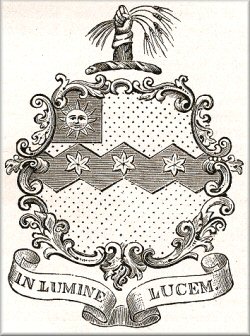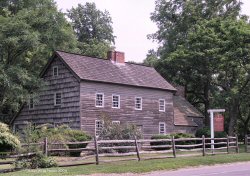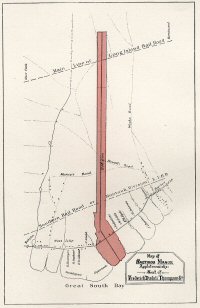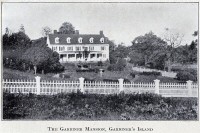Crest: A cubit arm erect or vested gules, cuff argent, holding in the hand five ears of wheat proper. Motto: In Lumine lucem.

Please remember that the scans are copyrighted 2004 by Susan White Pieroth. This material may be used in your personal research database, but it may not be published, including on another website, without specific permission. However, this is now available at https://archive.org/details/newyorkgenealogi1896gree. Also of local interest is History of Suffolk County, New York, by W.W. Munsell & Co., 1882.
The document begins on page one of the issue.
Vo.. XXVII. NEW YORK JANUARY, 1896. No. I.
_________________________
THE FAMILY OF THOMPSON, OF THE
COUNTY OF SUFFOLK, NEW
YORK.
{Revised and corrected from former articles in the Record, January,
1891.}
_________________________
By Frederick Diodati-Thompson,
LL.B.
_________________________
John Thompson, {footnote} the ancestor of the Thompsons of the county of Suffolk, came to Asford, [Setauket] Long Island, in 1656, and with Colonel Richard Woodhull, Colonel Richard Floyd, and others, was one of the fifty-five original proprietors of the town of Brookhaven. By allotment of land and by purchase he became the owner of a large amount of real estate, which, on his death, he divided among his children. He married Hannah, daughter of Jonathan Brewster, son of Elder William Brewster, the most prominent of the band of Pilgrims who came over in the Mayflower, and sister of the Rev. Nathaniel Brewster, B.D. (born about 1620, died 1690), afterward the clergyman at Setauket, who graduated at Harvard College, 1642, in the first class, and was the first native-born person graduated in the New World. He went to England and took orders, and was settled at Alby, in Norfolk, for some years, but in 1662 returned to America and was minister of the First church in Boston, but settled finally at Brookhaven. Trinity College, Dublin, conferred on him the degree of Bachelor of Divinity. Brewster married Sarah Ludlow, daughter of the Worshipful Roger Ludlow, {footnote} a distinguished lawyer and deputy governor [page 3] of Massachusetts and Connecticut. His daughter, Hannah Brewster, afterward married her cousin, Samuel2 Thompson.
 John
Thompson, Esquire, resided near the public green, and was a refined and
scholarly man, and held in high estimation by his fellow-townsmen, who
frequently elected him to responsible town offices. He died October 14,
1688, leaving three sons, William, Anthony, and Samuel, and several
daughters,
one of whom, Elizabeth, married Job Smith, {footnote}
son of Richard Smith, the patentee of Smithtown, who purchased the
Indian
grant of Lion Gardiner (Gardiner received this valuable tract of land
as
a recompense for having ransomed the daughter of the Sachem Wyandance.
The deed to Lion Gardiner is in possession of the Long Island
Historical
Society). Smith made other purchases and procured a patent from
Governor
Nicolls in 1665, and from Governor Andros in 1677, and also a release
from
David Gardiner of the Lordship and Manor of Gardiner’s Island,
confirming
his father’s conveyance.
John
Thompson, Esquire, resided near the public green, and was a refined and
scholarly man, and held in high estimation by his fellow-townsmen, who
frequently elected him to responsible town offices. He died October 14,
1688, leaving three sons, William, Anthony, and Samuel, and several
daughters,
one of whom, Elizabeth, married Job Smith, {footnote}
son of Richard Smith, the patentee of Smithtown, who purchased the
Indian
grant of Lion Gardiner (Gardiner received this valuable tract of land
as
a recompense for having ransomed the daughter of the Sachem Wyandance.
The deed to Lion Gardiner is in possession of the Long Island
Historical
Society). Smith made other purchases and procured a patent from
Governor
Nicolls in 1665, and from Governor Andros in 1677, and also a release
from
David Gardiner of the Lordship and Manor of Gardiner’s Island,
confirming
his father’s conveyance.
Samuel2 Thompson, the youngest son, born March 4, 1668, was a farmer. He married Hannah, daughter of Rev. Nathaniel Brewster, and widow of Job Muncy. Her mother, as has been stated, was a daughter of Roger Ludlow, a lawyer of high standing who was the framer of the first code of laws of the colony of Connecticut. She was [page 4] his cousin, born May 19, 1679, and died November 17, 1755. She received a very superior education for those times.
Samuel2 Thompson, {footnote} Esquire, was in all respects an exemplary person, a leading individual in the Presbyterian Church, a gentleman of rare accomplishments, and was said to have been a very handsome man; he frequently served in the office of trustee of the town. Mr. Thompson, with Colonel Henry Smith of St. George’s Manor, Colonel Richard Floyd, Justice Adam Smith, Selah Strong, and Jonathan Owen, were the commissioners that had charge of the erection of the new church in 1710. He died July 14, 1749, leaving two sons, Jonathan and Isaac, and five daughters: 1st, Susannah, born 1707, married Thomas Strong, who was born June 5, 1708; married about 1730. Their son, Judge Selah Strong4, born December 25, 1737, married November 9, 1760, Anna Smith, born April 14, 1740, daughter of William Henry Smith {footnote} and Margaret Lloyd. {footnote} Mrs. Anna Smith Strong died August 12, 1812, aged seventy-two. Judge Strong was a delegate to the Provincial Congress in 1775, captain in the army, State Senator, and first Judge of the Court of Common Pleas of Suffolk County. He died at St. George’s Manor, July 4, 1815, aged seventy-seven.
Jonathan, the eldest son, remained at Setauket, and inherited the valuable real and personal estate of his father. Jonathan3 above named as born October 25, 1710, and married September 30, 1734, Mary Woodhull, {footnote} born April 11, 1711, daughter of Richard Woodhull, 3d. [page 5] She was a first cousin of the distinguished General Woodhull. (General Woodhull served as major under General Abercrombie at Ticonderoga and Crown Point, with Lieutenant-Colonel Bradstreet at the capture of Fort Frontenac, and in 1760 served as colonel of the 3d New York Provincials under General Amherst; was at the surrender of the Marquis de Vaudreuil which effected the final reduction of Canada. He afterwards had an important command in the Revolutionary army, and distinguished himself at the battle of Long Island, where he received a wound from which he never recovered. Being captured by a detachment of dragoons and the 71st Regiment of Foot, he was struck down by a loyalist officer after he had surrendered. His wife was Ruth, daughter of Nicoll Floyd, and sister of William Floyd who was a signer of the Declaration of Independence. He left one child, who married, 1st, Henry Nicoll, and 2d, General John Smith of Mastic.)
Jonathan3
Thompson, Esquire, was, like his
father, a very extensive farmer and a justice of the peace for nearly
forty
years. He was a gentleman of great intelligence and prudence, a lover
of
peace and concord, and shared through life the esteem and confidence of
all his fellow-citizens. His death occurred June 5, 1786, and that of
his
widow January 30, 1801. She was a person of literary acquirements,
gentle
disposition, and possessed a refined nature which justly endeared her
to
all her acquaintances. They had four sons and two daughters, viz.: Mary4,
born November 25, 1735, married Thomas Smith, Esq., son of Edmund Smith
of Smithtown, and died Mary 23, 1794, leaving only one child a daughter
Anna who married Richard Floyd of Setauket, a descendant of Colonel
Richard
Floyd, {footnote} one of the
fifty-five original settlers
of Brookhaven, who [page
6]
with Richard Woodhull,
Esquire, and John Thompson, Esquire, were the principal persons in that
settlement; Hannah4, daughter of Jonathan3
Thompson,
born October 5, 1747, married Colonel Benajah Strong of Islip (his
sister
married, as his 2d wife, General William Floyd of Mastic) [page
7] –she died February 1, 1786, leaving children, Samuel,
Nancy, Mary,
Benajah, Elizabeth, and William; Nathan4,
youngest son of Jonathan3,
died in infancy; Jonathan4, third son of Jonathan3,
born February 14, 1745, died unmarried September 14, 1773, on his
passage
from St. Eustatia to New York, where he had been on business; Isaac4,
second son of Jonathan3, was born January 18,
1743; and Samuel4,
{footnote} eldest son of
Jonathan3, was
born October 2, 1738.  Jonathan3
Thompson purchased for his son {footnote}
[page
8] Isaac4, in 1758, the estate on the
south side of the
island known as Sagtikos {footnote}
Patent or Manor,
on a neck of land called Appletree Wicke. For this beautiful property
he
paid £1,200 New York money, which sum he brought
over from
the north side in his saddle-bags on a handsome gray horse. The
original
charter or patent for this property, dated 1697, from King William the
Third, signed by Colonel Benjamin Fletcher, then governor of New York,
with the great seal of the province attached, is still in the
possession
of the family. The quit rent was one shilling a year in lieu [page
9] of all services whatever, Sagtikos Manor, Appletree Wicke,
is at
present the sole property of Frederick Diodati7
Thompson, he
having purchased the rights of the other heirs in 1894. It is a fine
estate
of twelve hundred and six acres, being a narrow strip of land about
eight
miles long. Judge Isaac4 Thompson {footnote}
died here January 30, 1816. He had been a magistrate for more than
forty
years, a judge of the Court of Common Pleas, and a representative of
the
County of Suffolk in the Assembly in 1795. He was a man of sincere
piety
and the strictest integrity. His manners were mild, elegant, and
courteous,
and in the discharge of all his official duties he manifested sound
judgment
united with firmness and impartiality.
Jonathan3
Thompson purchased for his son {footnote}
[page
8] Isaac4, in 1758, the estate on the
south side of the
island known as Sagtikos {footnote}
Patent or Manor,
on a neck of land called Appletree Wicke. For this beautiful property
he
paid £1,200 New York money, which sum he brought
over from
the north side in his saddle-bags on a handsome gray horse. The
original
charter or patent for this property, dated 1697, from King William the
Third, signed by Colonel Benjamin Fletcher, then governor of New York,
with the great seal of the province attached, is still in the
possession
of the family. The quit rent was one shilling a year in lieu [page
9] of all services whatever, Sagtikos Manor, Appletree Wicke,
is at
present the sole property of Frederick Diodati7
Thompson, he
having purchased the rights of the other heirs in 1894. It is a fine
estate
of twelve hundred and six acres, being a narrow strip of land about
eight
miles long. Judge Isaac4 Thompson {footnote}
died here January 30, 1816. He had been a magistrate for more than
forty
years, a judge of the Court of Common Pleas, and a representative of
the
County of Suffolk in the Assembly in 1795. He was a man of sincere
piety
and the strictest integrity. His manners were mild, elegant, and
courteous,
and in the discharge of all his official duties he manifested sound
judgment
united with firmness and impartiality.
Judge Thompson was active during the Revolutionary war in organizing the militia and was chairman of the Islip committee. He wrote several letters to the Continental Congress in relation to affairs on Long Island. Dr. Samuel4 Thompson of Setauket was also one of the principal men of Brookhaven engaged in providing means of defence against the anticipated invasion of the British troops. February 15, 1776, he sent an important letter to Congress enclosing maps of the harbors, descriptions of the beaches, etc. He recommended the erection of a fort near Setauket to have an armament of six or eight guns, and another at Stony Book to have two six or nine pounders. He also wished a capable gunsmith sent to them.
In 1777 more than three hundred light horse, on their was east, bivouacked for the night on the estate of Judge Thompson, and made, as usual, free use of his property. The commanding officers, among whom was Sir Henry Clinton, in their tours of the island, frequently stayed at Sagtikos. On one occasion the house was assaulted in the night by some British sailors belonging to a vessel of war, and Judge Thompson was himself dragged by a rope around his neck across the highway, and threatened with death, but was saved by one of their number saying that, as he was a magistrate under the king, they should not hang him. He was also fired at while going up-stairs in his house, but fortunately was not hit. The bullet is in possession of his great grandson, Samuel Ludlow7 Thompson, Esq., who resides at Islip. They took with them some of his furniture and carried it on board of a frigate at New York, but he succeeded in having it restored to him after much trouble. Honorable Isaac4 Thompson was the founder of the Presbyterian Church at Babylon. His grandson, David5 Thompson, presented an ancient bell to this church in 1838, which originally hung in a Spanish convent. It had a fine silver tone but was not considered loud enough, and was therefore subsequently sold and replaced by one of American manufacture. Judge Thompson’s wife, Mary Gardiner, was daughter of Colonel Abraham Gardiner of Easthampton. They were married June 4, 1772, and had children, two sons, Jonathan5 and Abraham Gardiner5, both of whom became distinguished citizens of New York City. It is related that after his marriage he brought his wife from Easthampton to Sagtikos on a pillion behind him on his horse.
[page 10] Colonel Gardiner, the father of Mrs. Thompson, was the second son of David Gardiner, fourth Lord of the Manor of Gardiner’s Island; he resided at Easthampton, and was a leading character on Long Island during the war of the Revolution. Colonel Gardiner, as executor, had charge of the manor during the minority of John Lyon Gardiner, the seventh Lord and proprietor, and as Gardiner’s bay was occupied by the British fleet under Admiral Arbuthnot, who obtained from the island nearly all their provisions, his duty to his ward obliged him to be careful in his conduct, so that the "British would not vent their spite against this young gentleman," who was not of age. Nevertheless Colonel Gardiner co-operated with Lieutenant-Colonel Livingston, who commanded the troops on the east end of Long Island, until the town of Easthampton was occupied by a detachment of British soldiers under Sir William Erkine.
 As
Colonel Gardiner’s house was the finest in Easthampton, it was
naturally
selected as the headquarters, and he entertained, at different times,
Lord
Percy, Lord Cathcart, Governor Tryon, Major André, and others. The
unfortunate André was a great favorite in the family, and left with
them several mementos of friendship; and two of the wineglasses from
his
camp chest, presented by him to Colonel Gardiner on the eve of his
departure
in exchange for two of Colonel Gardiner’s, are still preserved in the
family,
one being the property of Frederick Diodati7
Thompson of Sagtikos
Manor, the other of Colonel J. Lyon7 Gardiner of
the Manor of
Gardiner’s Island. [Image of Gardiner Manor from In
Olde New
York by Charles Burr Todd, Grafton Press, 1907]
As
Colonel Gardiner’s house was the finest in Easthampton, it was
naturally
selected as the headquarters, and he entertained, at different times,
Lord
Percy, Lord Cathcart, Governor Tryon, Major André, and others. The
unfortunate André was a great favorite in the family, and left with
them several mementos of friendship; and two of the wineglasses from
his
camp chest, presented by him to Colonel Gardiner on the eve of his
departure
in exchange for two of Colonel Gardiner’s, are still preserved in the
family,
one being the property of Frederick Diodati7
Thompson of Sagtikos
Manor, the other of Colonel J. Lyon7 Gardiner of
the Manor of
Gardiner’s Island. [Image of Gardiner Manor from In
Olde New
York by Charles Burr Todd, Grafton Press, 1907]
Dr. Nathaniel Gardiner, son of Colonel Gardiner, who studied medicine under the celebrated Drs. Shippen and Rush of Philadelphia, severed in the was as surgeon in the First New Hampshire Regiment.
Colonel Gardiner married Mary Smith, {footnote} a descendant of Richard Smith of Smithtown. Their children were: 1st Rachel, married Colonel David Mulford and afterward John Gardiner, of the manor of Eaton’s Neck.
2d, Dr. Nathaniel, married Eliza Dering (the Derings were one of the best families of the County of Kent, England).
3d, Mary, married Judge Thompson.
4th, Captain Abraham of the Militia (which title he went by to distinguish him from his father), married Phoebe Dayton. He had children: Abraham S. (married Abby Lee, and left descendants mention in note on Nicoll family); Mary (married Philip G. Van Wyck, a grandson of General Van Cortlandt, of the manor, and had: Joanna; Cortlandt, died unmarried, a midshipman United States Navy; Eliza, married William Van Ness Livingston; Pierre C.; and Anna Van Rensellaer, married Judge Alexander Wells—their daughter, Gertrude Van Cortlandt, married Schuyler Hamilton); David (married Juliana McLachlan of Jamaica, West Indies, whose grandfather commanded the united clans of McLachlan and McLean at the battle of Culloden, Scotland, and was beheaded for treason). The children of David were: Julia (who married John Tyler, President of the United States, and had children—David Gardiner; John Alexander, who was decorated by the Emperor of Germany for bravery on the field of battle in the Franco-German war; Lyon [page 11] G., President of William and Mary College, Virginia; Lachlan; Fitzwalter; Julia, who married ____ Spencer, Esq., of Geneseo; and Margaret, who married, November 13, 1884, Honorable William Mumford Ellis, Speaker of the House of Delegates, Virginia); Alexander (died unmarried, Clerk of the United States Circuit Court, N. Y.); Margaret (married John Beeckman, and had one child, Henry, who was killed by a fall from his hours in Virginia, August 4, 1875; Mr. Beekman was killed by the accidental discharge of his gun while shooting; Mr. Beekman’s mother was a Livingston; and Colonel David Lion who married his cousin Sarah Gardiner7, daughter of David6 Thompson, and has David, Sarah Diodati, and Robert Alexander, B. A. Yale 1887). Samuel S. son of Captain Abraham, married Mary, daughter of Hon. Ezra L’Hommedieu, a member of Congress, and a descendant of the Sylvester family, of Shelter Island. [He had Mary (who married Professor Eben N. Horsford of Harvard University); Phoebe (who also married Professor Horsford after the death of her sister Mary); Frances (who married Professor George Martin Lane of Harvard University, and had children—Gardiner; a daughter, Louisa Greenough, who married Bayard Van Rensselaer of Albany; and Katharine Ward, who died 1893).]
Nathaniel, son of Captain Abraham, married Eliza Francis, and had John B., William H., and Eliza, married Dr. I. Hartshorne.
Dr. Nathaniel, son of Colonel Gardiner, had two children, Robert S. who died unmarried, and Eliza P. who married Reuben Brumley, and died without children.